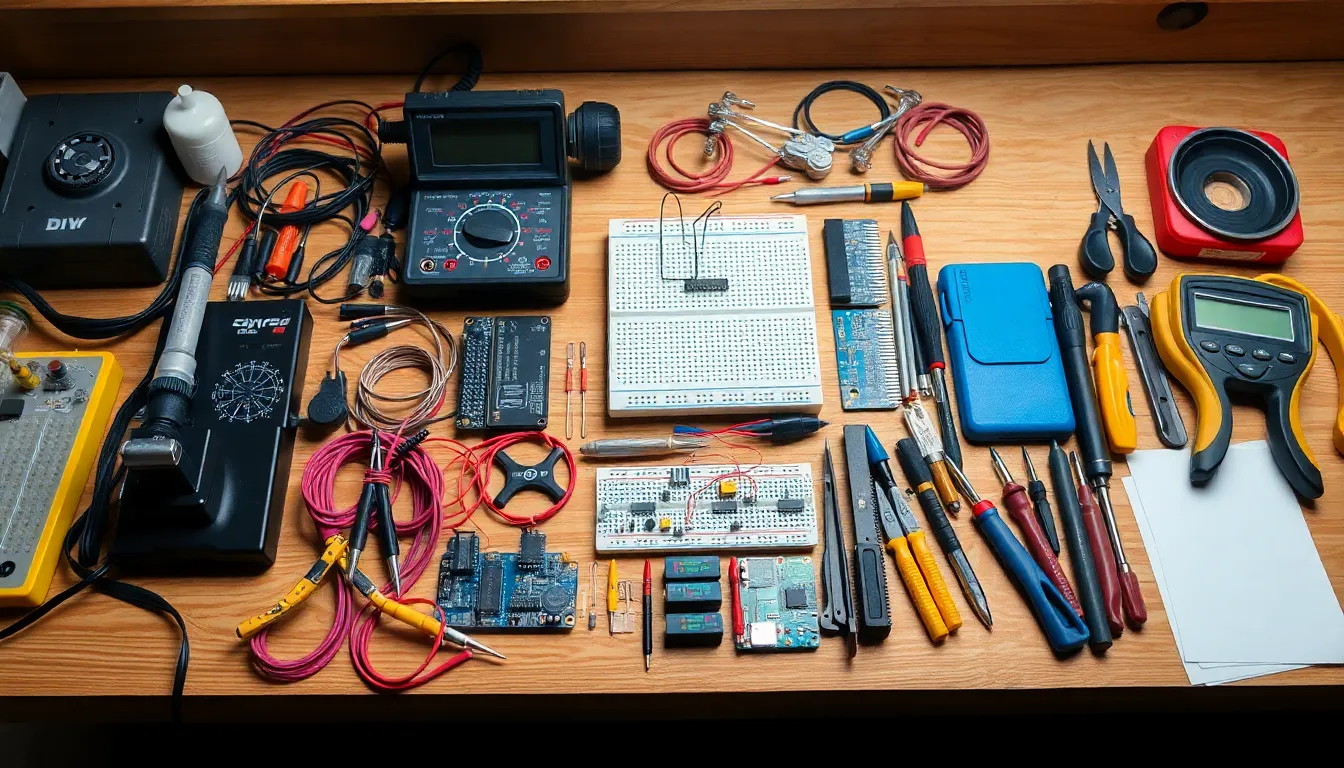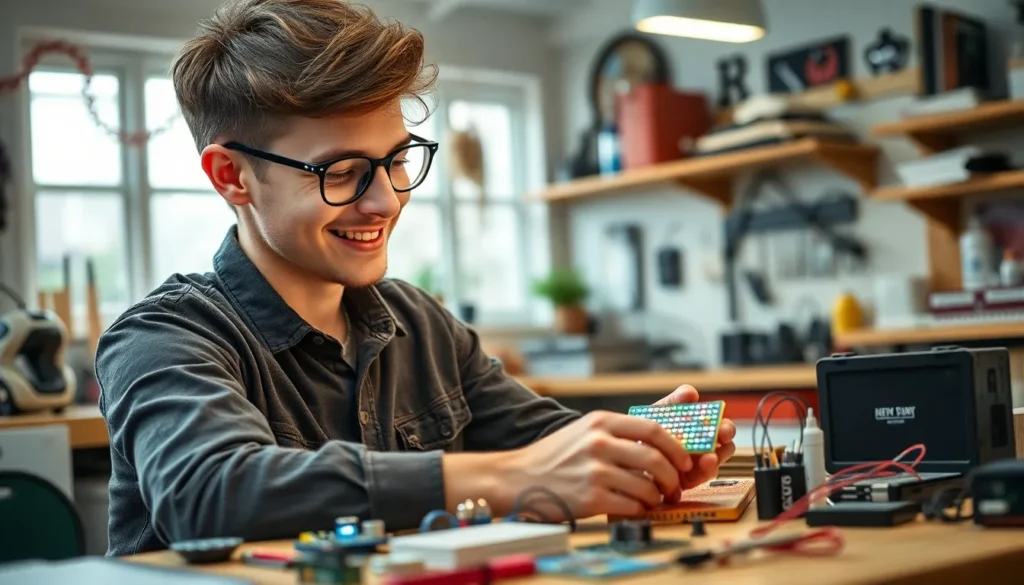Looking to unleash your inner inventor? DIY electronics projects are the perfect playground for creativity and innovation. Whether it’s turning an old toaster into a smart speaker or creating a quirky LED display, there’s no shortage of fun ideas waiting to spark your imagination. Plus, who wouldn’t want to impress friends with homemade gadgets that scream, “I’m a genius!”?
From beginners to seasoned tech wizards, these projects cater to all skill levels. They offer a chance to learn new skills while having a blast. So grab those wires and circuit boards—it’s time to dive into the electrifying world of DIY electronics. Get ready to tinker, create, and maybe even invent the next must-have gadget. After all, who needs a fancy store-bought gift when you can gift your friends a homemade robot that serves snacks?
Table of Contents
ToggleOverview of DIY Electronics Projects
DIY electronics projects offer engaging opportunities for creativity and hands-on learning. Individuals can explore various projects ranging from simple circuits to complex devices. Concepts such as programming, soldering, and circuitry become accessible through these initiatives.
Examples of projects include creating a smart home device that controls lighting and temperature. Another possibility involves building a custom audio amplifier for better sound quality. Each project not only enhances technical skills but also fosters problem-solving capabilities.
Several resources are available for beginners and experienced hobbyists. Websites frequently offer tutorials, project ideas, and forums for collaboration. Community workshops and maker spaces also provide essential tools and expertise, inviting participants to share knowledge.
DIY electronics projects often incorporate popular components like microcontrollers, sensors, and LEDs. Using microcontrollers such as Arduino or Raspberry Pi simplifies programming and control. Sensors allow for interactions with the environment, while LEDs add visual elements to projects.
An impressive array of personal creations can result from these efforts. Designs may include automated plant watering systems or custom gaming consoles. Unique gadgets impress peers and serve as personalized gifts with a deeper value than commercial items.
Engagement in DIY electronics nurtures innovation and self-expression, appealing to a broad audience. The hands-on nature of these projects satisfies both technical interest and artistic intent. Skills gained through these projects inevitably translate into practical knowledge applicable in everyday life.
Essential Tools for DIY Electronics

DIY electronics projects require specific tools for efficient assembly and experimentation. Having the right equipment simplifies the creative process and enhances project outcomes.
Basic Tools Needed
Soldering iron is crucial for connecting components securely. Wire cutters and strippers facilitate precise adjustments. Multimeter measures voltage, current, and resistance, confirming that circuits function properly. Breadboards allow easy assembly and modification of prototypes without soldering. Jumper wires connect various parts of the circuits, making flexibility achievable. Screwdrivers assist in securing components and casings. Together, these basic tools form the foundation for any DIY electronics project.
Advanced Tools for Enthusiasts
Oscilloscope offers detailed insights into circuit behavior by displaying waveforms. Programmers enable the seamless upload of code to microcontrollers. Hot glue gun provides strong adhesion for components while maintaining a clean finish. Desoldering pump helps in correcting mistakes, allowing for easier component replacements. Power supply units supply consistent voltage, ensuring circuits receive the right amount of power. Each advanced tool enhances capability and precision for more complex endeavors in DIY electronics.
Popular DIY Electronics Projects
Exploring DIY electronics projects opens doors to creativity and hands-on learning. Numerous options cater to different skill levels, making electronics accessible for everyone.
Beginner-Friendly Projects
Start with simple LED circuits to practice basic concepts. These projects require minimal components and often include a breadboard, resistors, and LEDs. Building a light-sensitive LED involves a photoresistor that controls brightness depending on ambient light. Another easy project is a USB-powered fan, which requires simple wiring and minimal tools. These projects instill confidence and encourage experimentation from the outset.
Intermediate Challenges
Intermediate enthusiasts can tackle projects requiring more components and design skills. Creating a smart temperature sensor using an Arduino enhances understanding of coding and circuitry. Advantages include real-time temperature monitoring and data logging via simple code. Another engaging project is a custom audio amplifier. This device improves sound quality for personal speakers and can be built with readily available parts. Each project expands technical skills and invites creative troubleshooting.
Advanced Creations
Advanced creators can dive into complex projects involving extensive programming and specialized components. Building a home automation system allows control of lights and appliances through smartphones or voice commands. Components like relays and sensors make this project both functional and innovative. Designing a quadcopter represents another exciting venture; it requires knowledge of flight dynamics, electronics integration, and programming. These projects challenge skills and deepen the understanding of DIY electronics dramatically.
Tips for Success in DIY Electronics
Success in DIY electronics hinges on a systematic approach and learning to navigate challenges. Adopting the right strategies enhances creativity and boosts project outcomes.
Research and Planning
Effective research fuels creativity in DIY electronics projects. Engaging with online tutorials, forums, and video demonstrations provides valuable insights. Understanding each component’s function lays a solid foundation. Drafting a project plan helps visualize the steps needed for execution. Identifying necessary materials before starting saves time and reduces frustration. Utilizing design software for schematics can simplify complex ideas. Checking community resources ensures access to tools and support. Gathering feedback from experienced hobbyists fosters growth and improvement. Tracking progress throughout the project enhances learning and builds confidence.
Overcoming Common Challenges
Many face common challenges in DIY electronics that require practical solutions. Troubleshooting circuits often becomes necessary when projects don’t function as expected. Regularly testing connections helps identify issues early. Adjusting to unexpected component failures teaches adaptability in design. Learning basic soldering techniques enhances reliability in connections. Overcoming project limitations is possible by seeking creative solutions online. Utilizing simulation software before physical assembly minimizes errors. Joining local maker spaces or online communities provides support and encouragement. Documenting successes and failures promotes continuous improvement in skills.
Exploring DIY electronics projects opens up a world of creativity and innovation. Whether transforming everyday items or building advanced gadgets, the journey is as rewarding as the final product. Each project offers a chance to learn new skills and enhance problem-solving abilities.
With a wealth of resources available, anyone can dive into this exciting field. From basic tools to advanced equipment, having the right resources makes a significant difference in project success. Engaging with communities and sharing experiences further enriches the DIY electronics journey.
Ultimately, the satisfaction of creating something unique and functional can’t be overstated. These projects not only impress friends and family but also foster a deeper understanding of technology and design. Embrace the challenge and let imagination lead the way.

